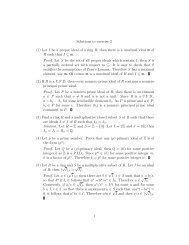Topics in algebra Chapter IV: Commutative rings and modules I - 1
Topics in algebra Chapter IV: Commutative rings and modules I - 1
Topics in algebra Chapter IV: Commutative rings and modules I - 1
You also want an ePaper? Increase the reach of your titles
YUMPU automatically turns print PDFs into web optimized ePapers that Google loves.
5 Projective <strong>modules</strong> <strong>and</strong> <strong>in</strong>jective <strong>modules</strong><br />
We first <strong>in</strong>troduce the notion: free <strong>modules</strong>.<br />
Def<strong>in</strong>ition 5.1 Let F be an R-module. F is a free module if there is a<br />
subset X = {ei | i ∈ Λ} (which is called a basis) of F such that F = (X),<br />
i.e., for every x ∈ F , there are e1, . . . , en ∈ X <strong>and</strong> r1, . . . , rn ∈ R such<br />
n<br />
that x = riei, <strong>and</strong> that X is l<strong>in</strong>ear <strong>in</strong>dependent, i.e., for every f<strong>in</strong>ite set<br />
i=1<br />
{e1, . . . , en} of X with<br />
F ∼ = ⊕i∈ΛR.<br />
n<br />
riei = 0, then ri = 0 for every i. In this case,<br />
i=1<br />
If F is free with a f<strong>in</strong>ite basis then F ∼ = R n for some n <strong>and</strong> F is called a free<br />
R-module of rank n.<br />
We now <strong>in</strong>troduce the notion: projective <strong>modules</strong>.<br />
Def<strong>in</strong>ition 5.2 Let P be an R-module. P is said to be projective if for any<br />
exact sequence M g<br />
−→ N −→ 0 <strong>and</strong> R-homomorphism f : P −→ N there is<br />
an R-homomorphism h : P −→ M such that g ◦ h = f.<br />
It is easy to see that free <strong>modules</strong> are projective.<br />
There are several equivalent characterizations for projective <strong>modules</strong>.<br />
Proposition 5.3 Let R be a r<strong>in</strong>g. Then the follow<strong>in</strong>g are equivalent for an<br />
R-module P :<br />
(a) P is projective.<br />
(b) Any s.e.s. of the form 0 −→ L f<br />
−→ M g<br />
−→ P −→ 0 splits.<br />
(c) P is a direct summ<strong>and</strong> of some free R-module F .<br />
Proof. (a) ⇒ (b) Let 0 −→ L f<br />
−→ M g<br />
−→ P −→ 0 be a s.e.s.. Let i : P −→ P<br />
be the identity map; then there is a R-homomorphism h : P −→ M such<br />
that g ◦ h = i, so that g ◦ h = idP ,i.e., the s.e.s. splits.<br />
(b) ⇒ (c) Let X = {xi | i ∈ Λ} be a generat<strong>in</strong>g set of P ; then there is a free<br />
module F = ⊕i∈ΛR <strong>and</strong> a R-epimorphism g : F −→ P . Let K be the kernel<br />
of g; then 0 −→ K i<br />
−→ F g<br />
−→ P −→ 0 is a s.e.s., so that the sequence splits<br />
132



